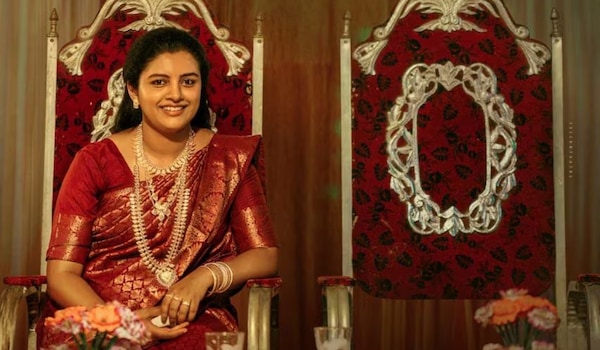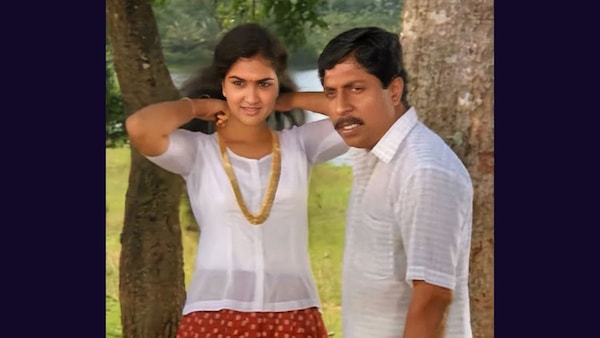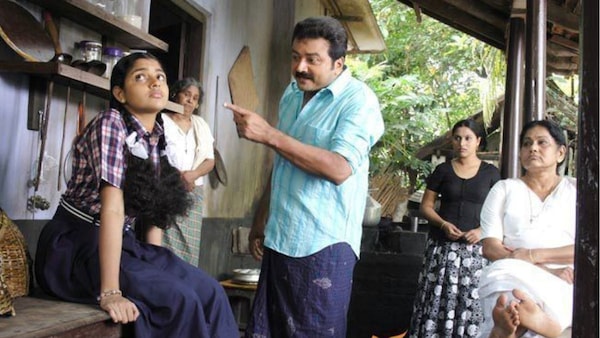Gold As Power, Oppression & Agency—Three Films, Three Perspectives
From Ponmuttayidunna Tharavu to Ponman, Malayalam cinema’s portrayal of gold and dowry has undergone a striking shift—from enabling patriarchal norms to actively challenging them.

Promo poster for Ponman.
Last Updated: 12.46 PM, Feb 20, 2025
THERE IS A POIGNANT SCENE in Ponman when jewellery broker PP Ajesh (Basil Joseph) delicately lays down the promised gold before Steffi (Lijomol Jose) and offhandedly instructs her to try them on. Steffi gently rebukes him by telling him she will do that privately. As Ajesh exits, he catches Steffi gazing longingly at the gold, prompting a knowing smirk—perhaps a telling assumption about women’s affinity for gold jewellery. However, as the narrative unfolds, it becomes clear that Steffi’s relationship with gold is one of survival. In her coastal town in Kollam, where a woman’s marriage prospects are inextricably linked to dowry and gold, Steffi, who is already past her marriageable age, is in a precarious situation. The harsh reality becomes apparent during a visit by the mother of a prospective groom, whose conversation is entirely transactional. The niceties are casually put aside, as the mother lets them know that if they aren’t willing to pay the promised Gold, they can quickly take a detour and fix the next alliance. Directed by debutant Jyothish Sankar, Ponman, written by GR Indugopan, is a scathing critique of patriarchy, with dowry serving as a stark illustration of the system’s oppressive nature.
Though Ponman is told through Ajesh’s perspective, especially his struggles with gold for survival, it is the muted voices and desperate struggles of women who hold your undivided attention. What’s distressing are the unspoken images of violence, marital rape, and stifled voices, as women are stripped of their agency and forced to perpetuate the cycle of abuse. Gold becomes a potent symbol of patriarchal oppression, silencing women and entrapping them in a never-ending cycle of suffering. Especially heart-wrenching is Steffi’s ordeal as she navigates her wedding night with trepidation, fiercely safeguarding her gold from Ajesh and negotiating with her cold, abusive husband. Her desperation stems from her knowledge that once her gold is transferred to her husband’s family, her position in the household will turn immaterial. In a way both her mother and mother-in-law are casualties of this oppressive system, desperate to secure their daughter’s future, yet unable to halt the intergenerational abuse or empathise with Steffi’s plight, perhaps due to their own experiences as victims.

Though Mario’s discovery of Steffi’s secret gold transaction with Ajesh does spark a tense confrontation, he learns to temper his anger for his self-interest, as he requires the gold to secure his sister's future and his own. But when battle lines are drawn between Mario and Ajesh, Steffi undergoes a transformative awakening, finally developing a conscience and breaking free from the shackles of oppression. What’s truly liberating in Ponman is Steffi’s arc, shattering the pattern of exploitation, reclaiming her agency, and walking toward freedom.
Interestingly three decades ago, Sathyan Anthikad had crafted a nuanced comedy-drama Ponmuttayidunna Tharavu (1988) — remade as Dus Tola in Hindi — which explored the intricate politics of gold, dowry, and patriarchy. Set in a fictional village in central Kerala, it tells the story of a young goldsmith, Bhaskaran (Sreenivasan) who is madly in love with his neighbourhood astrologer’s daughter Snehalatha (Urvashi). When Snehalatha suggests that he gift her a 10-gm gold necklace to impress her father and prove his love, Bhaskaran obliges. But his world comes crashing down when she refuses to acknowledge the necklace and also chooses a more affluent suitor. Though the spectre of dowry looms large over the narrative, Snehalatha’s agency turns out to be a subversion. Not only does she exploit her father’s greed to navigate a precarious situation, but also ends up securing a wealthy husband. Unlike Ponman where Gold symbolises patriarchal oppression for women, Ponmuttayidunna Tharaavu uses gold as a clever motif to showcase a woman’s agency and cunning. That aside, the film also enables troubling patriarchal attitudes. By introducing a simplistic, kind-hearted female character (Shari) as a counterpoint to Snehalatha’s complexity, the film reinforces the notion that women are either virtuous and submissive or manipulative and selfish. Also, the narrative normalises a disturbing dynamic: an elderly Muslim man confining his young, beautiful wife within his mansion to shield her from prying eyes. And the cameo appearance of a popular actress (Parvathy) as the wife ends up sanitising this patriarchal trope.

Ironically the same Sathyan Anthikad nearly two decades later crafted one of the most disturbing instances of dowry endorsement in Bhagyadevatha (2009). The film’s protagonist driven by greed, marries a woman (Kaniha) for a hefty dowry. But when the promised money isn’t delivered, he not only denies her conjugal rights but also throws her out of this house and later shamelessly attempts to win her back after she wins a substantial lottery. The problem with the film lies not in its representation, but in its problematic resolution. Not only is the greedy, insensitive protagonist forgiven by the woman, but she even consents to pay off his sister’s dowry. Bhagyadevatha normalises dowry, misogyny and patriarchy, giving the notion that women should silently endure suffering and prioritise their husband’s families.

The contrast between the 2009 film's disturbing endorsement of dowry and the more recent Ponman is striking. While Bhagyadevatha perpetuated the notion that women are commodities to be bought and sold, Ponman marks a significant shift. This film not only tackles the evils of dowry head-on but also features a male protagonist who unequivocally condemns the practice. Moreover, the survivor's resilience and determination to stand up for herself also serve as a powerful testament to the importance of resistance and change.

 Premium
Premium